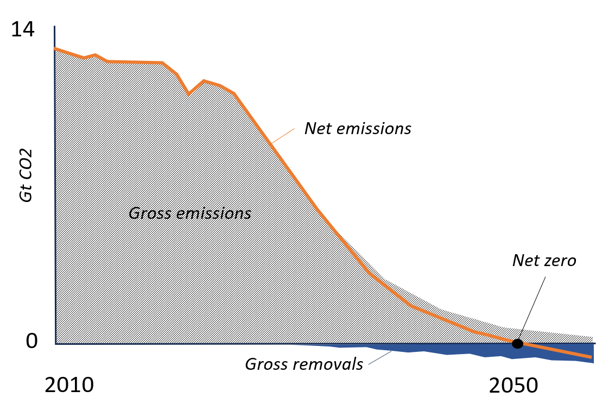The urgency to decarbonise the global economy is increasingly upon us. Calls for governments, companies and other organizations to commit to net-zero emissions are increasingly common as the effects of failing to limit climate change to the agreed 1.5°C become more apparent. But what is net-zero, why is it so important, and what’s the urgency? This blog goes back to basics on our net-zero ambitions and why they matter, and breaks down the essential role that CO2 capture, transport and storage (CCS) and carbon dioxide removal (CDR) have to play in reaching them.
Urgent action is needed to reach our goals
According to the EU’s climate service, global warming has exceeded 1.5°C compared to pre-industrial levels across an entire year for the first time, making it the hottest 12 consecutive months on record. Limiting long-term temperature increases to 1.5°C compared to pre-industrial levels was agreed upon by 196 countries in the Paris Agreement in 2015, a target strongly supported by world-leading organisations such as the UN’s Intergovernmental Panel on Climate Change (IPCC) and the International Energy Agency (IEA).
The IPCC has indicated that crossing the 1.5°C threshold will result in severe climate-change consequences, including more frequent and harsh droughts, heatwaves and rainfall. If we are to avoid extreme events similar to those experienced across the globe in 2023 becoming commonplace, we must reach our internationally agreed goal of limiting the global temperature increase to 1.5°C by achieving net-zero emissions by 2050 – but how?
Net Zero – what is it and why does it matter?
“Net-zero emissions” or “net zero” means massively reducing our gross greenhouse gas emissions to as close to zero as possible. Any remaining emissions should then be balanced by an equivalent amount of gross greenhouse gas removals. Put simply:
Net-zero emissions = gross emissions – gross removals = zero
There are several steps to reducing our gross emissions:
- Use energy efficiently: Energy efficiency and behaviour change – so called ‘low-hanging fruit’ – are fundamental for achieving net zero. Reducing energy use where we can and minimising our own carbon footprints are essential first steps.
- Scale-up and use clean energy supplies: Zero-carbon sources of electrification should be scaled up, such as renewables, nuclear, hydrogen. This clean electricity should be implemented in buildings, transport, and industry where feasible. Hydrogen can be used for situations where electrification is unsuitable or unfeasible.
- Decarbonise remaining energy use: CO2 emissions from hard-to-abate industries such as cement, steel and waste incineration should be captured and permanently stored.

However, some industries will have remaining gross emissions that cannot be eliminated by energy efficiency or switching to renewable energy. These “hard-to-abate” industries have a large carbon footprint and face significant challenges in decarbonisation.
For example, cement and steel are reliant on high temperatures (up to 1700°C) during the processing of raw materials that cannot be generated by renewable energy sources and consequently eliminating gross emissions by converting to renewables is not an option for them. Unavoidable direct process emissions, such as those associated with cement production and waste incineration, must also be addressed.
As such, a proportion of these remaining gross emissions will need to be balanced out using gross removals. These take two forms:
- Natural removals such as afforestation, tree restoration and agricultural soil management
- Engineered solutions such as Bioenergy with CCS (BECCS), Direct Air Capture (DAC) and Direct Ocean Capture (DOC).
While gross removals play an important role in ensuring we do not exceed the 1.5°C scenario, the longer we wait with gross emissions reductions, the more gross removals we will need to achieve net zero.
What is the role of CCS in achieving net zero?
CO2 capture, transport, and storage (CCS) describes the process of capturing carbon dioxide (CO2) emissions from point sources such as power plants or industrial sites, transporting it by ships, trucks or pipelines to a storage site, and injecting it in deep underground geological formations to permanently prevent it from reaching the atmosphere. CCS enables gross emissions reductions.

CCS technologies also provide the foundation for carbon dioxide removal (CDR) approaches, which can compensate for both historic and residual gross emissions by enabling gross removals. Unfortunately, natural removals alone will not be enough to compensate for residual gross emissions, and engineered solutions will be necessary. These solutions include bioenergy with CCS (BECCS), whereby CO2 from bio-based processes is captured and stored, and pulling carbon dioxide directly out of the air (Direct Air Capture – DAC) or the sea (Direct Ocean Capture – DOC). CDR technologies are often referred to as “negative emissions” or “climate positive solutions”.
Credible analyses of pathways for achieving net-zero emissions agree that the lowest cost and risk approach is to embrace a broad portfolio of technologies. CCS and CDR technologies are both crucial for achieving net-zero emissions, and can complement other sustainable solutions as part of a combined effort to decarbonise the global economy by 2050.
The latest IEA Roadmap to Net Zero report estimates that CCUS will account for 8% of emissions reductions, an estimated total of 6Gt per year by 2050. Hundreds of climate scenarios modelled by the IPCC also emphasise the crucial role of CCS in nearly all predictive outcomes that demonstrate the successful achievement of the climate goals outlined in the Paris Agreement.
CCS’ role in the green transition must be evaluated in relation to the emissions that cannot be feasibly reduced through energy efficiency, electrification, hydrogen, or increased renewable energy generation. CCS has a vital role to play in:
- Retrofitting existing industrial or power plants, to allow for their continued operation by capturing their CO2 emissions,
- Significantly reducing emissions from hard-to-abate industrial processes, such as cement, steel or chemicals,
- Enabling the low-carbon hydrogen economy, which can support the decarbonisation of industry, trucks and ships, and
- Removing CO2 from the atmosphere to balance emissions that are unavoidable or difficult to abate i.e. through BECCS or DAC.
While there are claims that CCS is unproven, too expensive, and perhaps even unsafe, the technology has been proven to work, and be safe and reliable. However, it is true that the current level of CCS implementation has had relatively little impact in terms of tonnes of CO2 stored per year at present day. Our challenge is to scale up the CCS industry to achieve the necessary gigatonnes of permanent storage in the coming decades.
What will drive us to reach our net zero targets?
Our main driver for action has to be mitigating climate change and avoiding its catastrophic impact on the planet and people. Our net-zero goals are designed to ensure any man-made CO2 emissions are removed from the atmosphere through technological or natural means.
Reaching net zero will require the deployment of several technologies and a global collaboration in order to do so. However, despite a general consensus on the essential role CCS has to play in this, breaking down the barriers to wide-scale CCS deployment is taking too long. We must scale up and reduce costs to reach economies of scale, and this will only possible if we maximise synergies between stakeholders, across borders and along the whole value chain.
Interest in CCS is high, and momentum is building, with cross-border engagement from research institutes, universities, industry actors, policy makers, politicians, and the general public. Agreements like the Paris Agreement provide a financial, technical and social framework within which to operate. Since the Paris Agreement, several other policy frameworks, such as The Green Deal, and, more recently, the Industrial Carbon Management Strategy, have been launched to drive the energy transition.
CCS is an essential tool in achieving net-zero emissions
While climate action has driven important political, technological and sociological changes so far, progress is happening far too slowly. The UN reported in 2023 that current climate policies point to a 2.8°C temperature rise by the end of the century.
Speeding-up and scaling-up the implementation of CCS is one of the necessary solutions to reach our net-zero targets. The most significant risk of not adopting CCS is the continued release of billions of tons of CO2 into the atmosphere from human activities.
The urgency is real, the time is now. We must work together to ensure an efficient and timely transition to net-zero.
In our next blog, we will analyse the role that policy has to play in driving CCS forward as a viable net-zero technology, through an analysis of the policy action currently being put in place to force change. Stay tuned.









Comments
No comments yet. Be the first to comment!